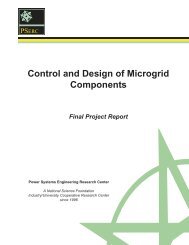Distributed Generation - Power Systems Engineering Research ...
Distributed Generation - Power Systems Engineering Research ...
Distributed Generation - Power Systems Engineering Research ...
You also want an ePaper? Increase the reach of your titles
YUMPU automatically turns print PDFs into web optimized ePapers that Google loves.
<strong>Power</strong> <strong>Systems</strong> <strong>Engineering</strong> <strong>Research</strong> Center<br />
PSERC Background Paper<br />
<strong>Distributed</strong> <strong>Generation</strong><br />
Robert H. Lasseter<br />
Professor Emeritus, Department of Electrical and Computer <strong>Engineering</strong><br />
University of Wisconsin-Madison<br />
September 4, 2003<br />
The electrical power system consists of three major components: generation, a<br />
high voltage transmission grid, and a distribution system. The high voltage<br />
transmission system links the generators to substations, which supply power to<br />
the user through the distribution system. Interruptions in these connecting links<br />
can disrupt the flow of power from generators to the users.<br />
Over the last ten years the reserve capacity in transmission has been falling due<br />
to increases in both electricity demand and generation capacity. This has<br />
resulted in an over utilized transmission system with an increasing likelihood of<br />
loss of power during a disturbance.<br />
One obvious solution is to build more transmission lines and improve reliability<br />
protocols. A not so obvious alternative is to integrate generation within the<br />
distribution system reducing the dependence of local loads on the transmission<br />
grid. This latter approach is referred to as distributed generation.<br />
It is generally agreed that any power production that is integrated within the<br />
distribution system is called distributed generation. <strong>Distributed</strong> generation<br />
encompasses a wide range of generator technologies, such as internal<br />
combustion engines, gas turbines, microturbines, fuel cells, photovoltaics and<br />
wind power. The larger units are normally gas turbines, large internal combustion<br />
engines, wind turbines and some fuel cells. Their ratings are in millions of watts<br />
of power at thousands of volts. The applications include direct power support at<br />
substations and deferral of the need to build more transmission.<br />
While placing distributed generation at substations will reduce the reliance on the<br />
high voltage transmission grid, it does introduce problems of control and dispatch<br />
of each unit. At a minimum, additional central real time monitoring and control<br />
systems need to be designed and implemented. The net result is an increase in
the power system’s complexity. An example that neglects this complexity is IEEE<br />
1547 Standard for Interconnecting <strong>Distributed</strong> Resources with Electric <strong>Power</strong><br />
<strong>Systems</strong>. This standard requires that distributed generators disconnect from the<br />
grid when there is a disturbance. In the case of a grid disturbance due to<br />
overload, disconnecting is exactly the wrong action since the system needs loads<br />
not generation to disconnect.<br />
It is obvious that indiscriminant application of distributed generation with central<br />
control can cause as many problems as it may solve. A better way to realize the<br />
emerging potential of distributed generation is to take a system approach which<br />
views generation and associated loads as a subsystem or a “microgrid”. This<br />
approach allows for control of distributed generation through load following<br />
techniques, reducing or eliminating the need for central dispatch. During<br />
disturbances, the generation and corresponding loads can separate from the<br />
distribution system to isolate the microgrid’s load from the disturbance (and<br />
thereby maintaining service) without harming the transmission grid’s integrity.<br />
This ability to island generation and loads together has a potential to provide a<br />
higher local reliability than that provided by the power system as a whole.<br />
Smaller units, having power ratings in thousands rather than millions of watts,<br />
can provide even higher reliability and fuel efficiency. These units are also<br />
clustered with loads creating microgrid services to customer sites such as office<br />
buildings, industrial parks and homes. Since the smaller units are modular, site<br />
management could decide to have more units than required by the customer<br />
load, providing local, online backup if one of the operating units failed.<br />
Most existing power plants, central or distributed, deliver electricity to user sites at<br />
an overall fuel-to-electricity efficiency in the range of 20-40%. This represents a loss<br />
of around 70% of the primary energy provided to the generator. To reduce this<br />
energy loss, it is necessary to either increase the fuel-to-electricity efficiency of the<br />
generation plant and/or use the waste heat. For site-based microgrids, it is much<br />
easier to place generators near the heat loads therebyallowing more effective use<br />
of waste heat than substation-based systems. Of course, there are special<br />
situations where the waste heat from large generators can also be utilized. These<br />
applications produce both electricity and the byproduct ofonsite thermal energy,<br />
converting 80 percent or more of the input fuel into useable energy. It also has the<br />
potential to dramatically reduce industrial sector carbon and air pollutant emissions.<br />
Economic, technology and environmental incentives, along with end user<br />
demands, are changing the face of electricity generation and transmission.<br />
Centralized generating facilities are giving way to smaller, more distributed units.<br />
Either type of microgrid could help shoulder the nation’s demand for more power,<br />
less complexity and higher local reliability without further overburdening the<br />
transmission grid.
Contact Information<br />
Robert H. Lasseter<br />
Site Director<br />
Professor Emeritus<br />
Electrical and Computer <strong>Engineering</strong><br />
University of Wisconsin-Madison<br />
1415 <strong>Engineering</strong> Drive<br />
Madison, WI 53706<br />
Phone: 608-262-0186<br />
Fax: 608-262-1267<br />
e-mail: lasseter@engr.wisc.edu<br />
<strong>Power</strong> <strong>Systems</strong> <strong>Engineering</strong> <strong>Research</strong> Center<br />
428 Phillips Hall<br />
Cornell University<br />
Ithaca, NY 14853-5401<br />
Phone: 607-255-5601<br />
© 2003 University of Wisconsin Board of Regents
















